Submitted:
08 September 2023
Posted:
12 September 2023
You are already at the latest version
Abstract
Keywords:
1. Introduction
1.1. Overview of the SARS-CoV-2 virus and its effect on humans
1.2. Concept of “Long COVID”
1.3. Relevance of Mining and Analysis of Social Media Data during Virus Outbreaks
2. Literature Review
- Lack of focus on Long COVID: As discussed in this section, a wide range of research questions in the context of COVID-19, such as – tourism [51], trending topics [52], concerns [52], event analysis [53], views towards wearing masks [55], analysis of behaviors of influencers [56], misinformation detection [57], analysis of addiction [60], detection of loneliness [62], and panic buying [64], have been explored and investigated in the last few months by studying and analyzing relevant Tweets. However, none of these works [51,52,53,55,56,57,60,62,64] focused on the analysis of Tweets about Long COVID.
- Limitations in the few works that exist on Long COVID: While there have been a few works, such as [72,73], that focused on the analysis of Tweets about Long COVID, the primary limitation of such works is the limited time range (for example: March 25, 2022, to April 1, 2022 in [72] and December 11, 2021, to December 20, 2021 in [73]) of the Tweets that were analyzed. Such limited time ranges represented only a small fraction of the total time Long COVID has impacted the global population.
- Lack of focus on self-reporting of Long COVID: Analysis of self-reporting of symptoms related to various health conditions on Twitter has attracted the attention of researchers from different disciplines, as is evident from the recent works related to Twitter data analysis that focused on self-diagnosis or self-reporting of mental health problems [74], autism [75], dementia [76], depression [77], breast cancer [78], swine flu [79], flu [80], chronic stress [81], post-traumatic stress disorder [82], and dental issues [83], just to name a few. Since the outbreak of COVID-19, works in this field (such as [63]) have focused on developing approaches to collect and analyze tweets where people self-reported symptoms of COVID-19. However, none of the prior works in this field have focused on investigating tweets comprising self-reporting of Long COVID.
3. Methodology
- a)
- VADER sets itself apart from LIWC by exhibiting heightened sensitivity to sentiment expressions thriving in the context of analysis of social media texts.
- b)
- The General Inquirer falls short in its coverage of sentiment-relevant lexical features that are commonplace in social text, a limitation that VADER adeptly addresses.
- c)
- The ANEW lexicon proves less responsive to the sentiment-relevant lexical features typically encountered in social text. This isn’t a limitation of VADER.
- d)
- The SentiWordNet lexicon exhibits substantial noise, with a significant portion of its synsets lacking positive or negative polarity. This isn’t a limitation of VADER.
- e)
- The Naïve Bayes classifier hinges on a simplistic assumption of feature independence, a limitation circumvented by VADER’s more nuanced approach.
- f)
- The Maximum Entropy approach, devoid of the conditional independence assumption between features, factors in information entropy through feature weightings.
- g)
- Machine learning classifiers, though robust, often demand extensive training data—a hurdle also faced by validated sentiment lexicons. Furthermore, machine learning classifiers rely on the training set to represent an extensive array of features.
- a)
- Removal of characters that are not alphabets.
- b)
- Removal of URLs.
- c)
- Removal of hashtags.
- d)
- Removal of user mentions.
- e)
- Detection of English words using tokenization.
- f)
- Stemming and Lemmatization.
- g)
- Removal of stop words
- h)
- Removal of numbers
- i)
- Replacing missing values.
4. Results and Discussions
5. Conclusions
Supplementary Materials
Funding
Data Availability Statement
Conflicts of Interest
References
- Zhu, N.; Zhang, D.; Wang, W.; Li, X.; Yang, B.; Song, J.; Zhao, X.; Huang, B.; Shi, W.; Lu, R.; et al. A Novel Coronavirus from Patients with Pneumonia in China, 2019. N. Engl. J. Med. 2020, 382, 727–733. [Google Scholar] [CrossRef] [PubMed]
- Drosten, C.; Günther, S.; Preiser, W.; van der Werf, S.; Brodt, H.-R.; Becker, S.; Rabenau, H.; Panning, M.; Kolesnikova, L.; Fouchier, R.A.M.; et al. Identification of a Novel Coronavirus in Patients with Severe Acute Respiratory Syndrome. N. Engl. J. Med. 2003, 348, 1967–1976. [Google Scholar] [CrossRef] [PubMed]
- Ksiazek, T.G.; Erdman, D.; Goldsmith, C.S.; Zaki, S.R.; Peret, T.; Emery, S.; Tong, S.; Urbani, C.; Comer, J.A.; Lim, W.; et al. A Novel Coronavirus Associated with Severe Acute Respiratory Syndrome. N. Engl. J. Med. 2003, 348, 1953–1966. [Google Scholar] [CrossRef] [PubMed]
- Zaki, A.M.; van Boheemen, S.; Bestebroer, T.M.; Osterhaus, A.D.M.E.; Fouchier, R.A.M. Isolation of a Novel Coronavirus from a Man with Pneumonia in Saudi Arabia. N. Engl. J. Med. 2012, 367, 1814–1820. [Google Scholar] [CrossRef]
- COVID - Coronavirus Statistics – Worldometer. Available online: https://www.worldometers.info/coronavirus/ (accessed on 3 September 2023).
- Zhou, P.; Yang, X.-L.; Wang, X.-G.; Hu, B.; Zhang, L.; Zhang, W.; Si, H.-R.; Zhu, Y.; Li, B.; Huang, C.-L.; et al. A Pneumonia Outbreak Associated with a New Coronavirus of Probable Bat Origin. Nature 2020, 579, 270–273. [Google Scholar] [CrossRef] [PubMed]
- Chan, J.F.-W.; Yuan, S.; Kok, K.-H.; To, K.K.-W.; Chu, H.; Yang, J.; Xing, F.; Liu, J.; Yip, C.C.-Y.; Poon, R.W.-S.; et al. A Familial Cluster of Pneumonia Associated with the 2019 Novel Coronavirus Indicating Person-to-Person Transmission: A Study of a Family Cluster. Lancet 2020, 395, 514–523. [Google Scholar] [CrossRef]
- Zhou, Y.; Zeng, Y.; Tong, Y.; Chen, C. Ophthalmologic Evidence against the Interpersonal Transmission of 2019 Novel Coronavirus through Conjunctiva. bioRxiv 2020.
- Cui, H.; Gao, Z.; Liu, M.; Lu, S.; Mo, S.; Mkandawire, W.; Narykov, O.; Srinivasan, S.; Korkin, D. Structural Genomics and Interactomics of 2019 Wuhan Novel Coronavirus, 2019-NCoV, Indicate Evolutionary Conserved Functional Regions of Viral Proteins. bioRxiv 2020.
- Chen, L.; Liu, W.; Zhang, Q.; Xu, K.; Ye, G.; Wu, W.; Sun, Z.; Liu, F.; Wu, K.; Zhong, B.; et al. RNA Based MNGS Approach Identifies a Novel Human Coronavirus from Two Individual Pneumonia Cases in 2019 Wuhan Outbreak. Emerg. Microbes Infect. 2020, 9, 313–319. [Google Scholar] [CrossRef]
- Ceraolo, C.; Giorgi, F.M. Genomic Variance of the 2019-nCoV Coronavirus. J. Med. Virol. 2020, 92, 522–528. [Google Scholar] [CrossRef]
- Gallagher, T.M.; Buchmeier, M.J. Coronavirus Spike Proteins in Viral Entry and Pathogenesis. Virology 2001, 279, 371–374. [Google Scholar] [CrossRef]
- Huang, C.; Wang, Y.; Li, X.; Ren, L.; Zhao, J.; Hu, Y.; Zhang, L.; Fan, G.; Xu, J.; Gu, X.; et al. Clinical Features of Patients Infected with 2019 Novel Coronavirus in Wuhan, China. Lancet 2020, 395, 497–506. [Google Scholar] [CrossRef] [PubMed]
- Lauring, A.S.; Hodcroft, E.B. Genetic Variants of SARS-CoV-2—What Do They Mean? JAMA 2021, 325, 529. [Google Scholar] [CrossRef] [PubMed]
- Khare, S.; GISAID Global Data Science Initiative (GISAID), Munich, Germany; Gurry, C. ; Freitas, L.; B Schultz, M.; Bach, G.; Diallo, A.; Akite, N.; Ho, J.; TC Lee, R.; et al. GISAID’s Role in Pandemic Response. China CDC Wkly. 2021, 3, 1049–1051. [Google Scholar] [CrossRef]
- GISAID - Gisaid.org. Available online: https://www.gisaid.org/ (accessed on 3 September 2023).
- Perego, E. The #LongCovid #COVID19 Available online:. Available online: https://twitter.com/elisaperego78/status/1263172084055838721?s=20 (accessed on 3 September 2023).
- Crook, H.; Raza, S.; Nowell, J.; Young, M.; Edison, P. Long Covid—Mechanisms, Risk Factors, and Management. BMJ 2021, 374, n1648. [Google Scholar] [CrossRef]
- Nabavi, N. Long Covid: How to Define It and How to Manage It. BMJ 2020, m3489. [Google Scholar] [CrossRef]
- Garg, P.; Arora, U.; Kumar, A.; Wig, N. The “Post-COVID” Syndrome: How Deep Is the Damage? J. Med. Virol. 2021, 93, 673–674. [Google Scholar] [CrossRef]
- Greenhalgh, T.; Knight, M.; A’Court, C.; Buxton, M.; Husain, L. Management of Post-Acute Covid-19 in Primary Care. BMJ 2020, m3026. [Google Scholar] [CrossRef] [PubMed]
- Raveendran, A.V. Long COVID-19: Challenges in the Diagnosis and Proposed Diagnostic Criteria. Diabetes Metab. Syndr. 2021, 15, 145–146. [Google Scholar] [CrossRef]
- Van Elslande, J.; Vermeersch, P.; Vandervoort, K.; Wawina-Bokalanga, T.; Vanmechelen, B.; Wollants, E.; Laenen, L.; André, E.; Van Ranst, M.; Lagrou, K.; et al. Symptomatic Severe Acute Respiratory Syndrome Coronavirus 2 (SARS-CoV-2) Reinfection by a Phylogenetically Distinct Strain. Clin. Infect. Dis. 2021, 73, 354–356. [Google Scholar] [CrossRef]
- Falahi, S.; Kenarkoohi, A. COVID-19 Reinfection: Prolonged Shedding or True Reinfection? New Microbes New Infect. 2020, 38, 100812. [Google Scholar] [CrossRef]
- Carfì, A.; Bernabei, R.; Landi, F. ; for the Gemelli Against COVID-19 Post-Acute Care Study Group Persistent Symptoms in Patients after Acute COVID-19. JAMA 2020, 324, 603. [Google Scholar] [CrossRef] [PubMed]
- Arnold, D.T.; Hamilton, F.W.; Milne, A.; Morley, A.J.; Viner, J.; Attwood, M.; Noel, A.; Gunning, S.; Hatrick, J.; Hamilton, S.; et al. Patient Outcomes after Hospitalisation with COVID-19 and Implications for Follow-up: Results from a Prospective UK Cohort. Thorax 2021, 76, 399–401. [Google Scholar] [CrossRef] [PubMed]
- Tenforde, M.W.; Kim, S.S.; Lindsell, C.J.; Billig Rose, E.; Shapiro, N.I.; Files, D.C.; Gibbs, K.W.; Erickson, H.L.; Steingrub, J.S.; Smithline, H.A.; et al. Symptom Duration and Risk Factors for Delayed Return to Usual Health among Outpatients with COVID-19 in a Multistate Health Care Systems Network — United States, March–June 2020. MMWR Morb. Mortal. Wkly. Rep. 2020, 69, 993–998. [Google Scholar] [CrossRef]
- Lopez-Leon, S.; Wegman-Ostrosky, T.; Perelman, C.; Sepulveda, R.; Rebolledo, P.A.; Cuapio, A.; Villapol, S. More than 50 Long-Term Effects of COVID-19: A Systematic Review and Meta-Analysis. Sci. Rep. 2021, 11, 1–12. [Google Scholar] [CrossRef]
- Ginsberg, J.; Mohebbi, M.H.; Patel, R.S.; Brammer, L.; Smolinski, M.S.; Brilliant, L. Detecting Influenza Epidemics Using Search Engine Query Data. Nature 2009, 457, 1012–1014. [Google Scholar] [CrossRef]
- Wolters Kluwer Health Available online:. Available online: https://www.apjtm.org/text.asp?2020/13/8/378/279651 (accessed on 3 September 2023).
- Charles-Smith, L.E.; Reynolds, T.L.; Cameron, M.A.; Conway, M.; Lau, E.H.Y.; Olsen, J.M.; Pavlin, J.A.; Shigematsu, M.; Streichert, L.C.; Suda, K.J.; et al. Using Social Media for Actionable Disease Surveillance and Outbreak Management: A Systematic Literature Review. PLoS One 2015, 10, e0139701. [Google Scholar] [CrossRef]
- Chew, C.; Eysenbach, G. Pandemics in the Age of Twitter: Content Analysis of Tweets during the 2009 H1N1 Outbreak. PLoS One 2010, 5, e14118. [Google Scholar] [CrossRef]
- Li, S.; Wang, Y.; Xue, J.; Zhao, N.; Zhu, T. The Impact of COVID-19 Epidemic Declaration on Psychological Consequences: A Study on Active Weibo Users. Int. J. Environ. Res. Public Health 2020, 17, 2032. [Google Scholar] [CrossRef]
- Bartlett, C.; Wurtz, R. Twitter and Public Health. J. Public Health Manag. Pract. 2015, 21, 375–383. [Google Scholar] [CrossRef]
- Tomaszewski, T.; Morales, A.; Lourentzou, I.; Caskey, R.; Liu, B.; Schwartz, A.; Chin, J. Identifying False Human Papillomavirus (HPV) Vaccine Information and Corresponding Risk Perceptions from Twitter: Advanced Predictive Models. J. Med. Internet Res. 2021, 23, e30451. [Google Scholar] [CrossRef]
- Lee, S.Y.; Khang, Y.-H.; Lim, H.-K. Impact of the 2015 Middle East Respiratory Syndrome Outbreak on Emergency Care Utilization and Mortality in South Korea. Yonsei Med. J. 2019, 60, 796. [Google Scholar] [CrossRef]
- Radzikowski, J.; Stefanidis, A.; Jacobsen, K.H.; Croitoru, A.; Crooks, A.; Delamater, P.L. The Measles Vaccination Narrative in Twitter: A Quantitative Analysis. JMIR Public Health Surveill. 2016, 2, e1. [Google Scholar] [CrossRef] [PubMed]
- Fu, K.-W.; Liang, H.; Saroha, N.; Tse, Z.T.H.; Ip, P.; Fung, I.C.-H. How People React to Zika Virus Outbreaks on Twitter? A Computational Content Analysis. Am. J. Infect. Control 2016, 44, 1700–1702. [Google Scholar] [CrossRef]
- Thakur, N. MonkeyPox2022Tweets: A Large-Scale Twitter Dataset on the 2022 Monkeypox Outbreak, Findings from Analysis of Tweets, and Open Research Questions. Infect. Dis. Rep. 2022, 14, 855–883. [Google Scholar] [CrossRef]
- Mouronte-López, M.L.; Ceres, J.S.; Columbrans, A.M. Analysing the Sentiments about the Education System Trough Twitter. Educ. Inf. Technol. 2023, 28, 10965–10994. [Google Scholar] [CrossRef] [PubMed]
- Li, X.; Hasan, S.; Culotta, A. Identifying Hurricane Evacuation Intent on Twitter. Proceedings of the International AAAI Conference on Web and Social Media 2022, 16, 618–627. [Google Scholar] [CrossRef]
- Lawelai, H.; Sadat, A.; Suherman, A. Democracy and Freedom of Opinion in Social Media: Sentiment Analysis on Twitter. prj 2022, 10, 40–48. [Google Scholar] [CrossRef]
- Thakur, N.; Han, C.Y. A Framework for Facilitating Human-Human Interactions to Mitigate Loneliness in Elderly. In Human Interaction, Emerging Technologies and Future Applications III; Springer International Publishing: Cham, 2021; pp. 322–327. ISBN 9783030553067. [Google Scholar]
- Thakur, N.; Han, C.Y. A Human-Human Interaction-Driven Framework to Address Societal Issues. In Human Interaction, Emerging Technologies and Future Systems V; Springer International Publishing: Cham, 2022; pp. 563–571. ISBN 9783030855390. [Google Scholar]
- Golder, S.; Stevens, R.; O’Connor, K.; James, R.; Gonzalez-Hernandez, G. Methods to Establish Race or Ethnicity of Twitter Users: Scoping Review. J. Med. Internet Res. 2022, 24, e35788. [Google Scholar] [CrossRef]
- Chang, R.-C.; Rao, A.; Zhong, Q.; Wojcieszak, M.; Lerman, K. #RoeOverturned: Twitter Dataset on the Abortion Rights Controversy. Proceedings of the International AAAI Conference on Web and Social Media 2023, 17, 997–1005. [Google Scholar] [CrossRef]
- Bhatia, K.V. Hindu Nationalism Online: Twitter as Discourse and Interface. Religions (Basel) 2022, 13, 739. [Google Scholar] [CrossRef]
- Peña-Fernández, S.; Larrondo-Ureta, A.; Morales-i-Gras, J. Feminism, gender identity and polarization in TikTok and Twitter. Comunicar 2023, 31, 49–60. [Google Scholar] [CrossRef]
- Goetz, S.J.; Heaton, C.; Imran, M.; Pan, Y.; Tian, Z.; Schmidt, C.; Qazi, U.; Ofli, F.; Mitra, P. Food Insufficiency and Twitter Emotions during a Pandemic. Appl. Econ. Perspect. Policy 2023, 45, 1189–1210. [Google Scholar] [CrossRef]
- Mehedi Shamrat, F.M.J.; Chakraborty, S.; Imran, M.M.; Muna, J.N.; Billah, M.M.; Das, P.; Rahman, M.O. Sentiment Analysis on Twitter Tweets about COVID-19 Vaccines Usi Ng NLP and Supervised KNN Classification Algorithm. Indones. J. Electr. Eng. Comput. Sci. 2021, 23, 463. [Google Scholar] [CrossRef]
- Sontayasara, T.; Jariyapongpaiboon, S.; Promjun, A.; Seelpipat, N.; Saengtabtim, K.; Tang, J.; Leelawat, N. ; Department of Industrial Engineering, Faculty of Engineering, Chulalongkorn University 254 Phayathai Road, Pathumwan, Bangkok 10330, Thailand; International School of Engineering, Faculty of Engineering, Chulalongkorn University, Bangkok, Thailand; Disaster and Risk Management Information Systems Research Group, Chulalongkorn University, Bangkok, Thailand Twitter Sentiment Analysis of Bangkok Tourism during COVID-19 Pandemic Using Support Vector Machine Algorithm. J. Disaster Res. 2021, 16, 24–30. [Google Scholar] [CrossRef]
- Asgari-Chenaghlu, M.; Nikzad-Khasmakhi, N.; Minaee, S. Covid-Transformer: Detecting COVID-19 Trending Topics on Twitter Using Universal Sentence Encoder. arXiv [cs.CL], 2020. [Google Scholar]
- Amen, B.; Faiz, S.; Do, T.-T. Big Data Directed Acyclic Graph Model for Real-Time COVID-19 Twitter Stream Detection. Pattern Recognit. 2022, 123, 108404. [Google Scholar] [CrossRef]
- Lyu, J.C.; Luli, G.K. Understanding the Public Discussion about the Centers for Disease Control and Prevention during the COVID-19 Pandemic Using Twitter Data: Text Mining Analysis Study. J. Med. Internet Res. 2021, 23, e25108. [Google Scholar] [CrossRef]
- Al-Ramahi, M.; Elnoshokaty, A.; El-Gayar, O.; Nasralah, T.; Wahbeh, A. Public Discourse against Masks in the COVID-19 Era: Infodemiology Study of Twitter Data. JMIR Public Health Surveill. 2021, 7, e26780. [Google Scholar] [CrossRef]
- Jain, S.; Sinha, A. Identification of Influential Users on Twitter: A Novel Weighted Correlated Influence Measure for Covid-19. Chaos Solitons Fractals 2020, 139, 110037. [Google Scholar] [CrossRef]
- Madani, Y.; Erritali, M.; Bouikhalene, B. Using Artificial Intelligence Techniques for Detecting Covid-19 Epidemic Fake News in Moroccan Tweets. Results Phys. 2021, 25, 104266. [Google Scholar] [CrossRef]
- Shokoohyar, S.; Rikhtehgar Berenji, H.; Dang, J. Exploring the Heated Debate over Reopening for Economy or Continuing Lockdown for Public Health Safety Concerns about COVID-19 in Twitter. Int. J. Bus. Syst. Res. 2021, 15, 650. [Google Scholar] [CrossRef]
- Chehal, D.; Gupta, P.; Gulati, P. COVID-19 Pandemic Lockdown: An Emotional Health Perspective of Indians on Twitter. Int. J. Soc. Psychiatry 2021, 67, 64–72. [Google Scholar] [CrossRef]
- Glowacki, E.M.; Wilcox, G.B.; Glowacki, J.B. Identifying #addiction Concerns on Twitter during the Covid-19 Pandemic: A Text Mining Analysis. Subst. Abus. 2021, 42, 39–46. [Google Scholar] [CrossRef]
- Selman, L.E.; Chamberlain, C.; Sowden, R.; Chao, D.; Selman, D.; Taubert, M.; Braude, P. Sadness, Despair and Anger When a Patient Dies Alone from COVID-19: A Thematic Content Analysis of Twitter Data from Bereaved Family Members and Friends. Palliat. Med. 2021, 35, 1267–1276. [Google Scholar] [CrossRef] [PubMed]
- Koh, J.X.; Liew, T.M. How Loneliness Is Talked about in Social Media during COVID-19 Pandemic: Text Mining of 4,492 Twitter Feeds. J. Psychiatr. Res. 2022, 145, 317–324. [Google Scholar] [CrossRef] [PubMed]
- Mackey, T.; Purushothaman, V.; Li, J.; Shah, N.; Nali, M.; Bardier, C.; Liang, B.; Cai, M.; Cuomo, R. Machine Learning to Detect Self-Reporting of Symptoms, Testing Access, and Recovery Associated with COVID-19 on Twitter: Retrospective Big Data Infoveillance Study. JMIR Public Health Surveill. 2020, 6, e19509. [Google Scholar] [CrossRef] [PubMed]
- Leung, J.; Chung, J.Y.C.; Tisdale, C.; Chiu, V.; Lim, C.C.W.; Chan, G. Anxiety and Panic Buying Behaviour during COVID-19 Pandemic—A Qualitative Analysis of Toilet Paper Hoarding Contents on Twitter. Int. J. Environ. Res. Public Health 2021, 18, 1127. [Google Scholar] [CrossRef]
- Pokharel, B.P. Twitter Sentiment Analysis during Covid-19 Outbreak in Nepal. SSRN Electron. J. 2020. [CrossRef]
- Vijay, T.; Chawla, A.; Dhanka, B.; Karmakar, P. Sentiment Analysis on COVID-19 Twitter Data. In Proceedings of the 2020 5th IEEE International Conference on Recent Advances and Innovations in Engineering (ICRAIE); IEEE; 2020; pp. 1–7. [Google Scholar]
- Shofiya, C.; Abidi, S. Sentiment Analysis on COVID-19-Related Social Distancing in Canada Using Twitter Data. Int. J. Environ. Res. Public Health 2021, 18, 5993. [Google Scholar] [CrossRef]
- Sahir, S.H.; Ayu Ramadhana, R.S.; Romadhon Marpaung, M.F.; Munthe, S.R.; Watrianthos, R. Online Learning Sentiment Analysis during the Covid-19 Indonesia Pandemic Using Twitter Data. IOP Conf. Ser. Mater. Sci. Eng. 2021, 1156, 012011. [Google Scholar] [CrossRef]
- Thakur, N. A Large-Scale Dataset of Twitter Chatter about Online Learning during the Current COVID-19 Omicron Wave. Data (Basel) 2022, 7, 109. [Google Scholar] [CrossRef]
- Pristiyono; Ritonga, M. ; Ihsan, M.A.A.; Anjar, A.; Rambe, F.H. Sentiment Analysis of COVID-19 Vaccine in Indonesia Using Naïve Bayes Algorithm. IOP Conf. Ser. Mater. Sci. Eng. 2021, 1088, 012045. [Google Scholar] [CrossRef]
- Lohar, P.; Xie, G.; Bendechache, M.; Brennan, R.; Celeste, E.; Trestian, R.; Tal, I. Irish Attitudes toward COVID Tracker App & Privacy: Sentiment Analysis on Twitter and Survey Data. In Proceedings of the The 16th International Conference on Availability, Reliability and Security; ACM: New York, NY, USA; 2021. [Google Scholar]
- Awoyemi, T.; Ebili, U.; Olusanya, A.; Ogunniyi, K.E.; Adejumo, A.V. Twitter Sentiment Analysis of Long COVID Syndrome. Cureus 2022. [CrossRef] [PubMed]
- Pitroda, H. Long Covid Sentiment Analysis of Twitter Posts to Understand Public Concerns. In Proceedings of the 2022 8th International Conference on Advanced Computing and Communication Systems (ICACCS); IEEE, 2022; Vol. 1; pp. 140–148. [Google Scholar]
- Coppersmith, G.; Dredze, M.; Harman, C.; Hollingshead, K. From ADHD to SAD: Analyzing the Language of Mental Health on Twitter through Self-Reported Diagnoses Available online:. Available online: https://aclanthology.org/W15-1201.pdf (accessed on 4 September 2023).
- Hswen, Y.; Gopaluni, A.; Brownstein, J.S.; Hawkins, J.B. Using Twitter to Detect Psychological Characteristics of Self-Identified Persons with Autism Spectrum Disorder: A Feasibility Study. JMIR MHealth UHealth 2019, 7, e12264. [Google Scholar] [CrossRef] [PubMed]
- Talbot, C.; O’Dwyer, S.; Clare, L.; Heaton, J.; Anderson, J. Identifying People with Dementia on Twitter. Dementia 2020, 19, 965–974. [Google Scholar] [CrossRef] [PubMed]
- Almouzini, S.; Khemakhem, M.; Alageel, A. Detecting Arabic Depressed Users from Twitter Data. Procedia Comput. Sci. 2019, 163, 257–265. [Google Scholar] [CrossRef]
- Clark, E.M.; James, T.; Jones, C.A.; Alapati, A.; Ukandu, P.; Danforth, C.M.; Dodds, P.S. A Sentiment Analysis of Breast Cancer Treatment Experiences and Healthcare Perceptions across Twitter. 2018. [CrossRef]
- Szomszor, M.; Kostkova, P.; de Quincey, E. 2009. In Lecture Notes of the Institute for Computer Sciences, Social Informatics and Telecommunications Engineering; Springer Berlin Heidelberg: Berlin, Heidelberg, 2011; pp. 18–26. ISBN 9783642236341. [Google Scholar]
- Alshammari, S.M.; Nielsen, R.D. Less Is More: With a 280-Character Limit, Twitter Provides a Valuable Source for Detecting Self-Reported Flu Cases. In Proceedings of the Proceedings of the 2018 International Conference on Computing and Big Data; ACM: New York, NY, USA; 2018. [Google Scholar]
- Yang, Y.-C.; Xie, A.; Kim, S.; Hair, J.; Al-Garadi, M.; Sarker, A. Automatic Detection of Twitter Users Who Express Chronic Stress Experiences via Supervised Machine Learning and Natural Language Processing. Comput. Inform. Nurs. Publish Ahead of Print. 2022. [Google Scholar] [CrossRef]
- Coppersmith, G.; Harman, C.; Dredze, M. Measuring Post Traumatic Stress Disorder in Twitter. Proceedings of the International AAAI Conference on Web and Social Media 2014, 8, 579–582. [Google Scholar] [CrossRef]
- Al-Khalifa, K.S.; Bakhurji, E.; Halawany, H.S.; Alabdurubalnabi, E.M.; Nasser, W.W.; Shetty, A.C.; Sadaf, S. Pattern of Dental Needs and Advice on Twitter during the COVID-19 Pandemic in Saudi Arabia. BMC Oral Health 2021, 21. [Google Scholar] [CrossRef]
- Tsytsarau, M.; Palpanas, T. Survey on Mining Subjective Data on the Web. Data Min. Knowl. Discov. 2012, 24, 478–514. [Google Scholar] [CrossRef]
- Saberi, B.; Saad, S. Sentiment Analysis or Opinion Mining: A Review Available online:. Available online: https://core.ac.uk/download/pdf/296919524.pdf (accessed on 4 September 2023).
- Liu, B. Sentiment Analysis and Opinion Mining; Springer Nature: Cham, Switzerland, 2022; ISBN 9783031021459. [Google Scholar]
- Medhat, W.; Hassan, A.; Korashy, H. Sentiment Analysis Algorithms and Applications: A Survey. Ain Shams Eng. J. 2014, 5, 1093–1113. [Google Scholar] [CrossRef]
- Wilson, T.; Wiebe, J.; Hoffmann, P. Recognizing Contextual Polarity in Phrase-Level Sentiment Analysis Available online:. Available online: https://aclanthology.org/H05-1044.pdf (accessed on 4 September 2023).
- Do, H.H.; Prasad, P.W.C.; Maag, A.; Alsadoon, A. Deep Learning for Aspect-Based Sentiment Analysis: A Comparative Review. Expert Syst. Appl. 2019, 118, 272–299. [Google Scholar] [CrossRef]
- Nazir, A.; Rao, Y.; Wu, L.; Sun, L. Issues and Challenges of Aspect-Based Sentiment Analysis: A Comprehensive Survey. IEEE Trans. Affect. Comput. 2022, 13, 845–863. [Google Scholar] [CrossRef]
- Hutto, C.; Gilbert, E. VADER: A Parsimonious Rule-Based Model for Sentiment Analysis of Social Media Text. Proceedings of the International AAAI Conference on Web and Social Media 2014, 8, 216–225. [Google Scholar] [CrossRef]
- Mierswa, I.; Wurst, M.; Klinkenberg, R.; Scholz, M.; Euler, T. YALE: Rapid Prototyping for Complex Data Mining Tasks. In Proceedings of the Proceedings of the 12th ACM SIGKDD international conference on Knowledge discovery and data mining; ACM: New York, NY, USA; 2006. [Google Scholar]
- Fung, M. Twitter-Long COVID 2023. Available online: https://www.kaggle.com/datasets/matt0922/twitter-long-covid-2023 (accessed on 5 September 2023).
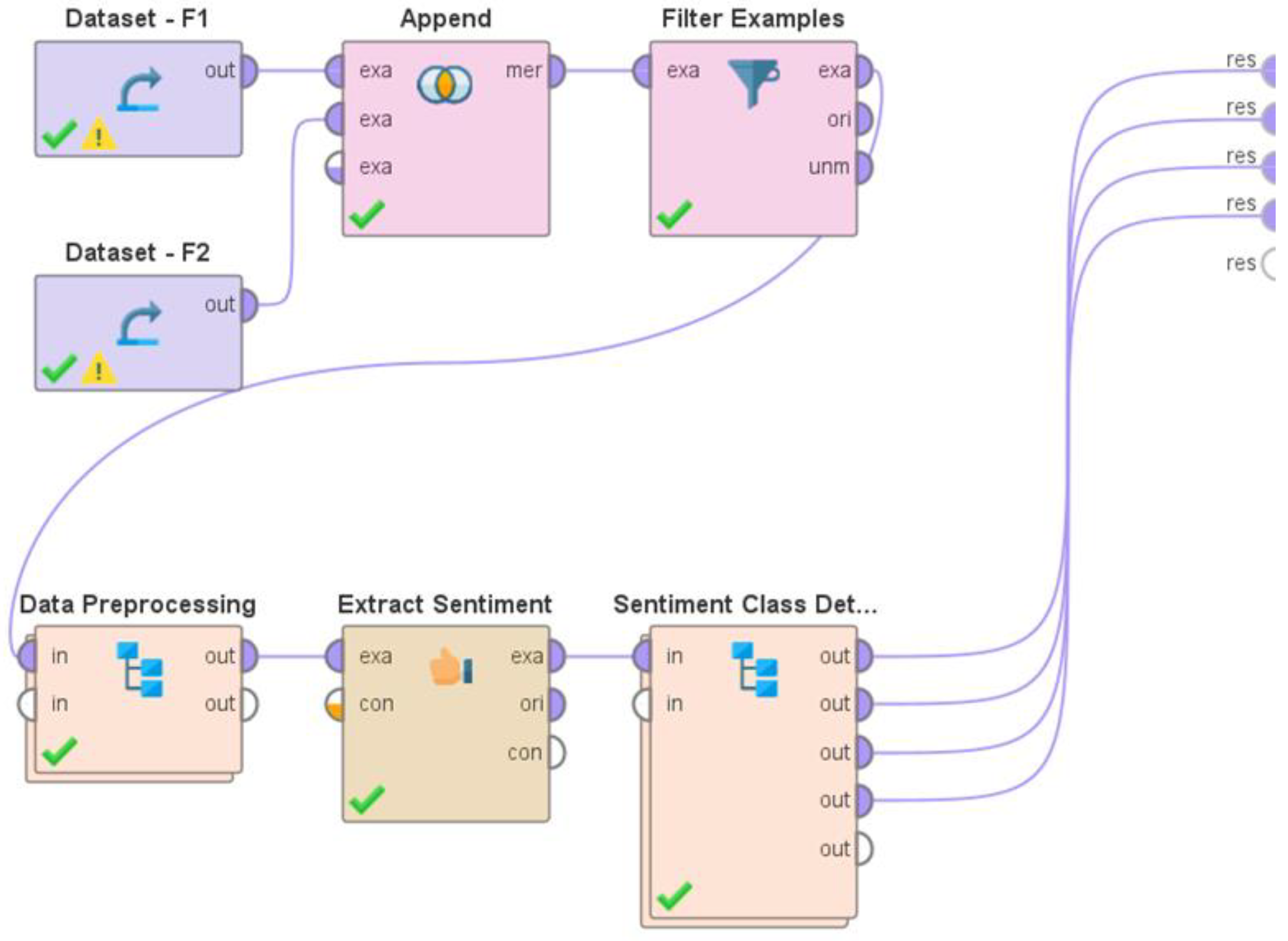
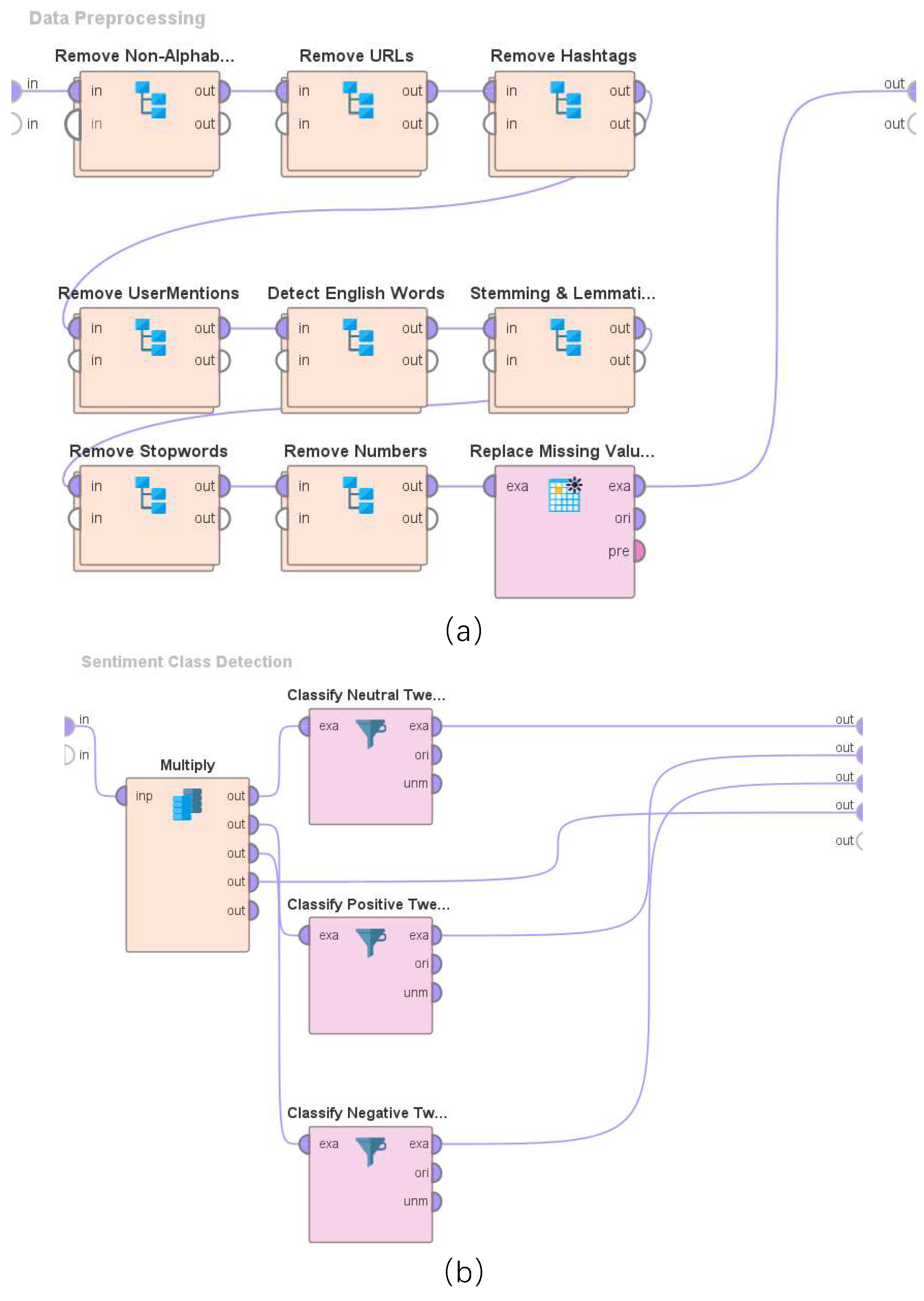
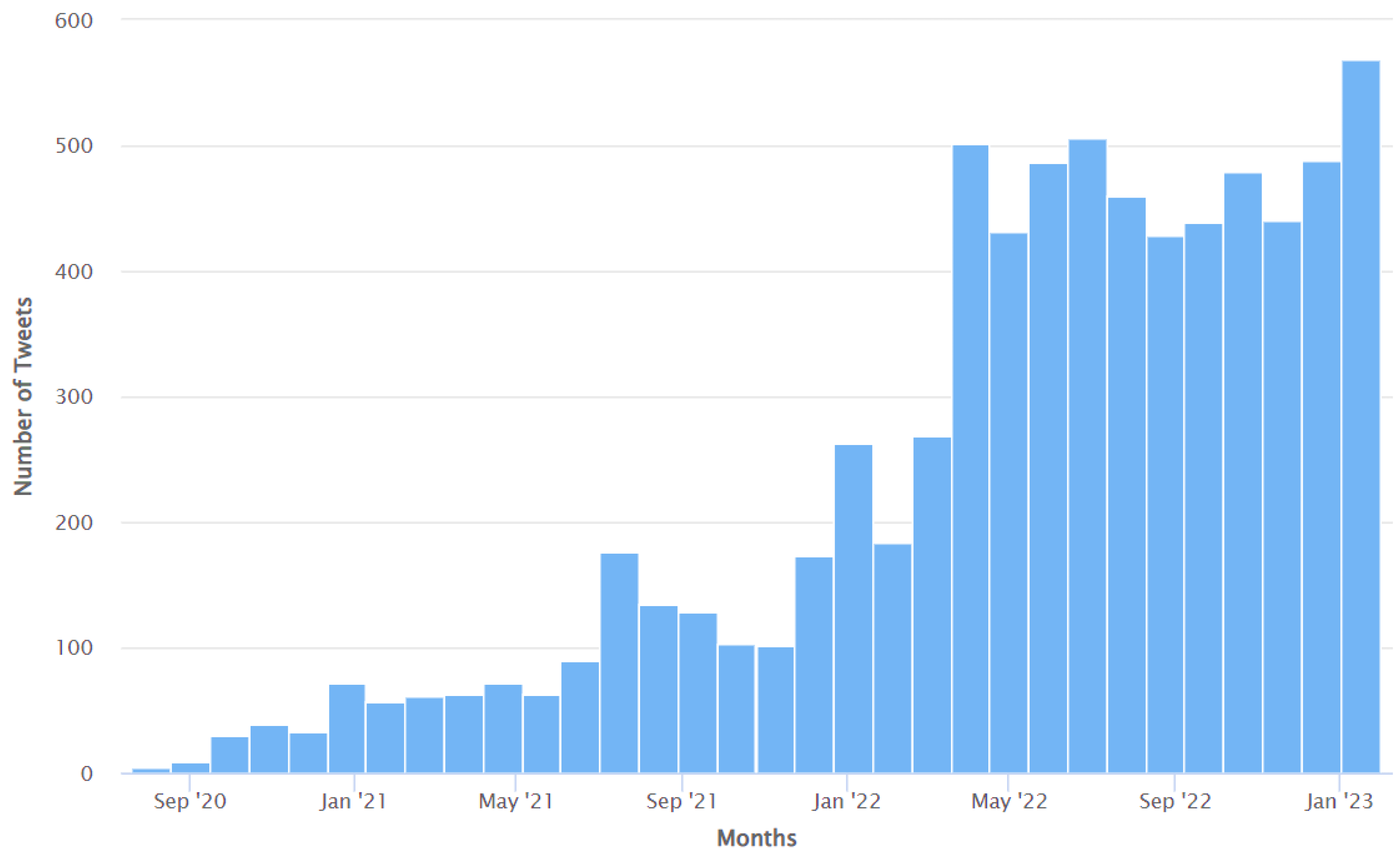
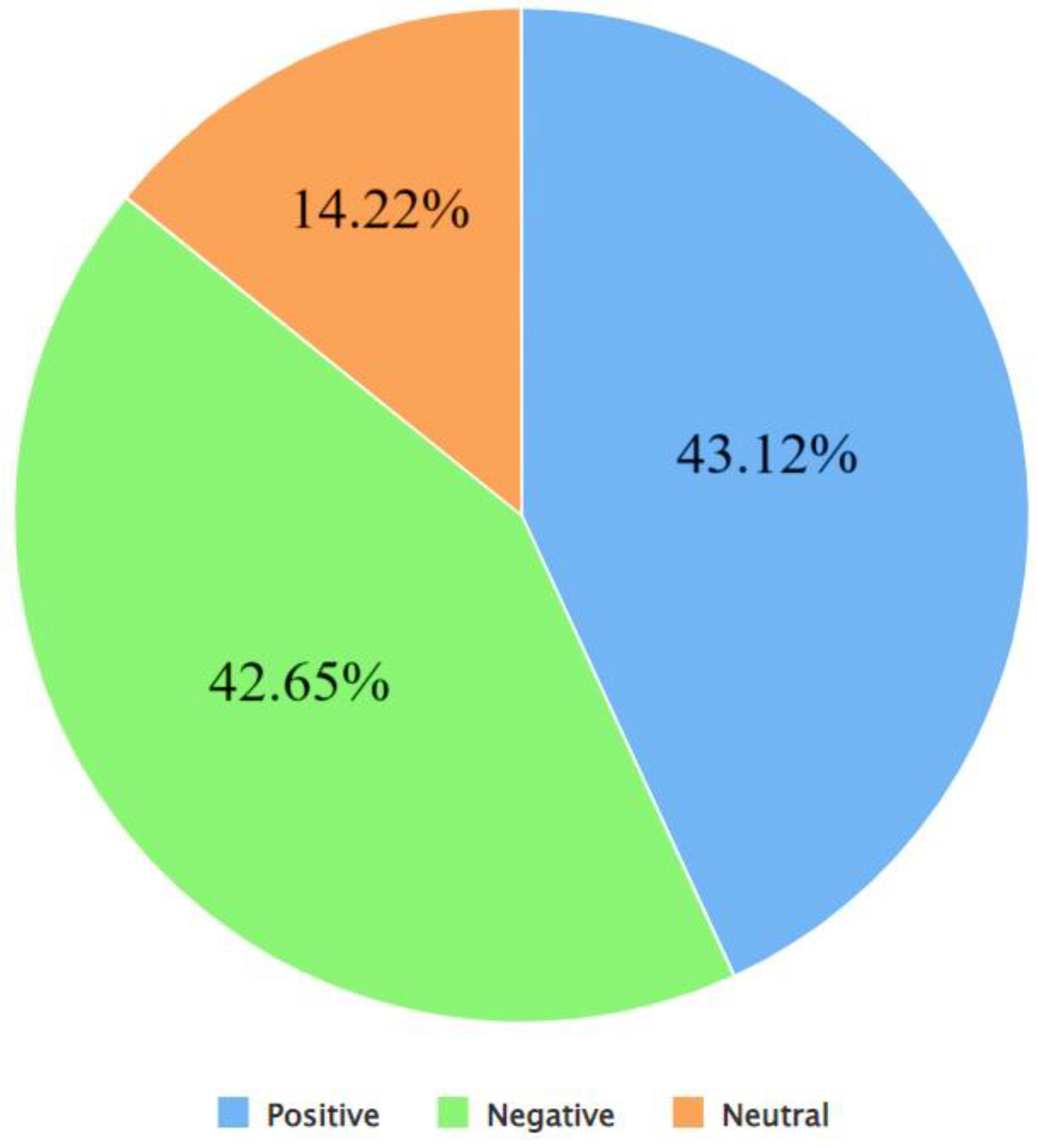
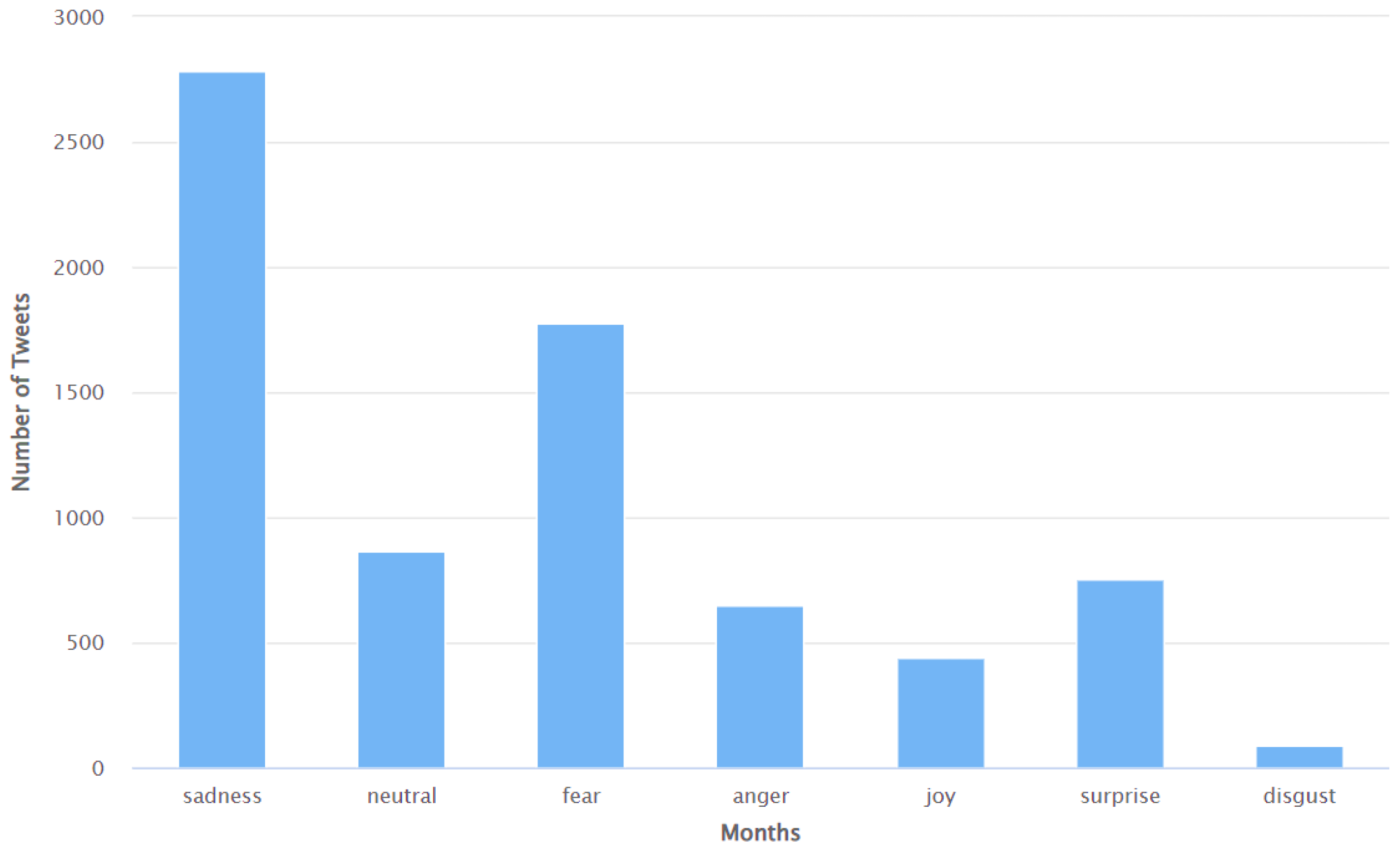
Disclaimer/Publisher’s Note: The statements, opinions and data contained in all publications are solely those of the individual author(s) and contributor(s) and not of MDPI and/or the editor(s). MDPI and/or the editor(s) disclaim responsibility for any injury to people or property resulting from any ideas, methods, instructions or products referred to in the content. |
© 2023 by the author. Licensee MDPI, Basel, Switzerland. This article is an open access article distributed under the terms and conditions of the Creative Commons Attribution (CC BY) license (https://creativecommons.org/licenses/by/4.0/).



